Change in Organizations and Leadership Interventions at Unilever
VerifiedAdded on 2022/12/15
|12
|2917
|257
Report
AI Summary
This report provides an analysis of the organizational changes implemented by Polman at Unilever in 2008, focusing on the strategic initiatives and leadership interventions employed. The research examines the context of the changes, the challenges encountered, such as resistance from employees and investors, and the leadership approaches that could have improved the outcomes. It utilizes concepts like force field analysis and leadership styles to evaluate the effectiveness of the change process. The report also explores potential leadership strategies, including increased collaboration, clear communication, and effective negotiation skills, to enhance stakeholder engagement and facilitate successful strategic change within the organization. The report highlights the importance of these strategies in overcoming resistance, fostering trust, and ensuring the successful implementation of change initiatives. The report concludes with a discussion of leadership approaches that could have been employed to improve the change process at Unilever. The report is a student contribution to Desklib, a platform providing AI-based study tools for students.
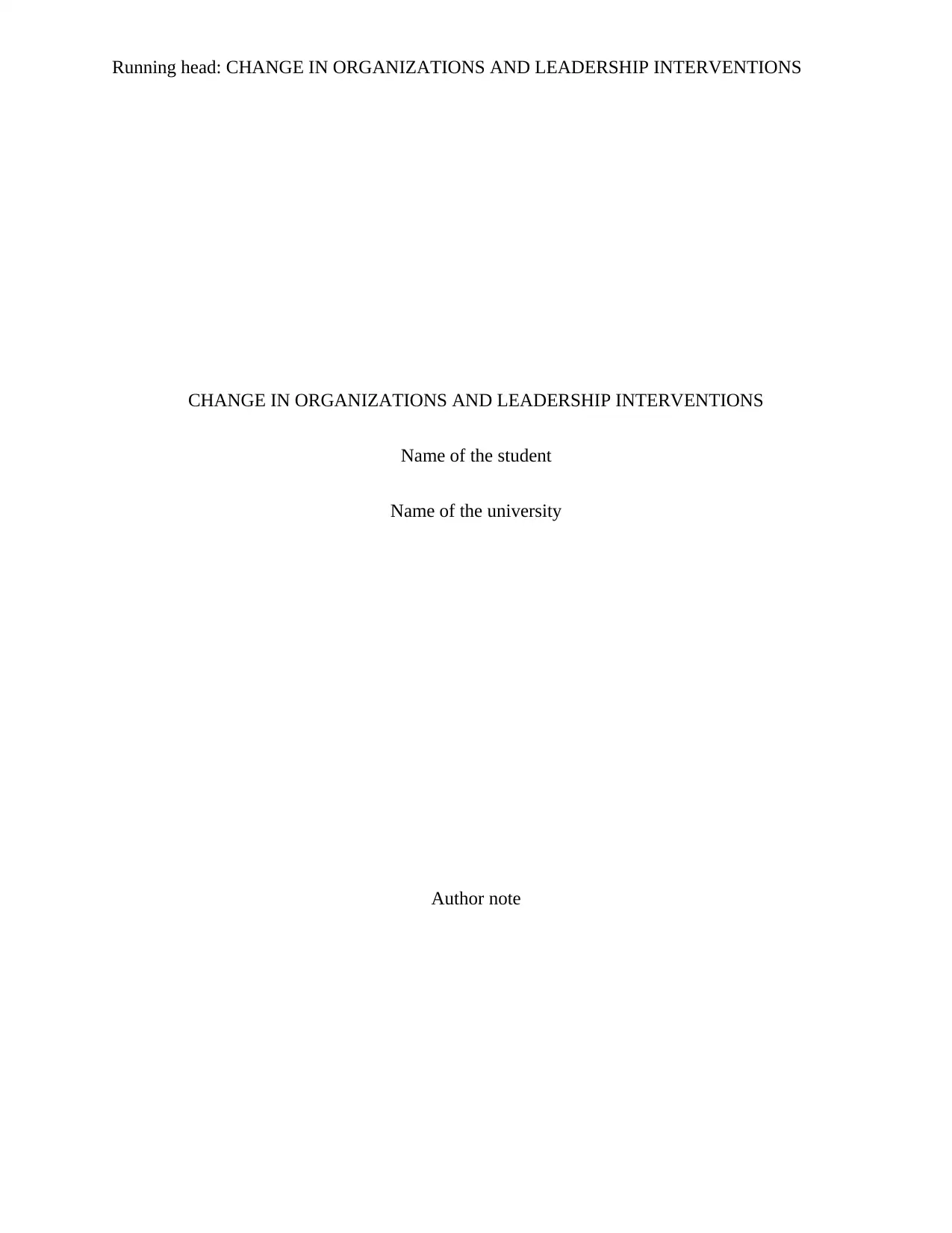
Running head: CHANGE IN ORGANIZATIONS AND LEADERSHIP INTERVENTIONS
CHANGE IN ORGANIZATIONS AND LEADERSHIP INTERVENTIONS
Name of the student
Name of the university
Author note
CHANGE IN ORGANIZATIONS AND LEADERSHIP INTERVENTIONS
Name of the student
Name of the university
Author note
Paraphrase This Document
Need a fresh take? Get an instant paraphrase of this document with our AI Paraphraser
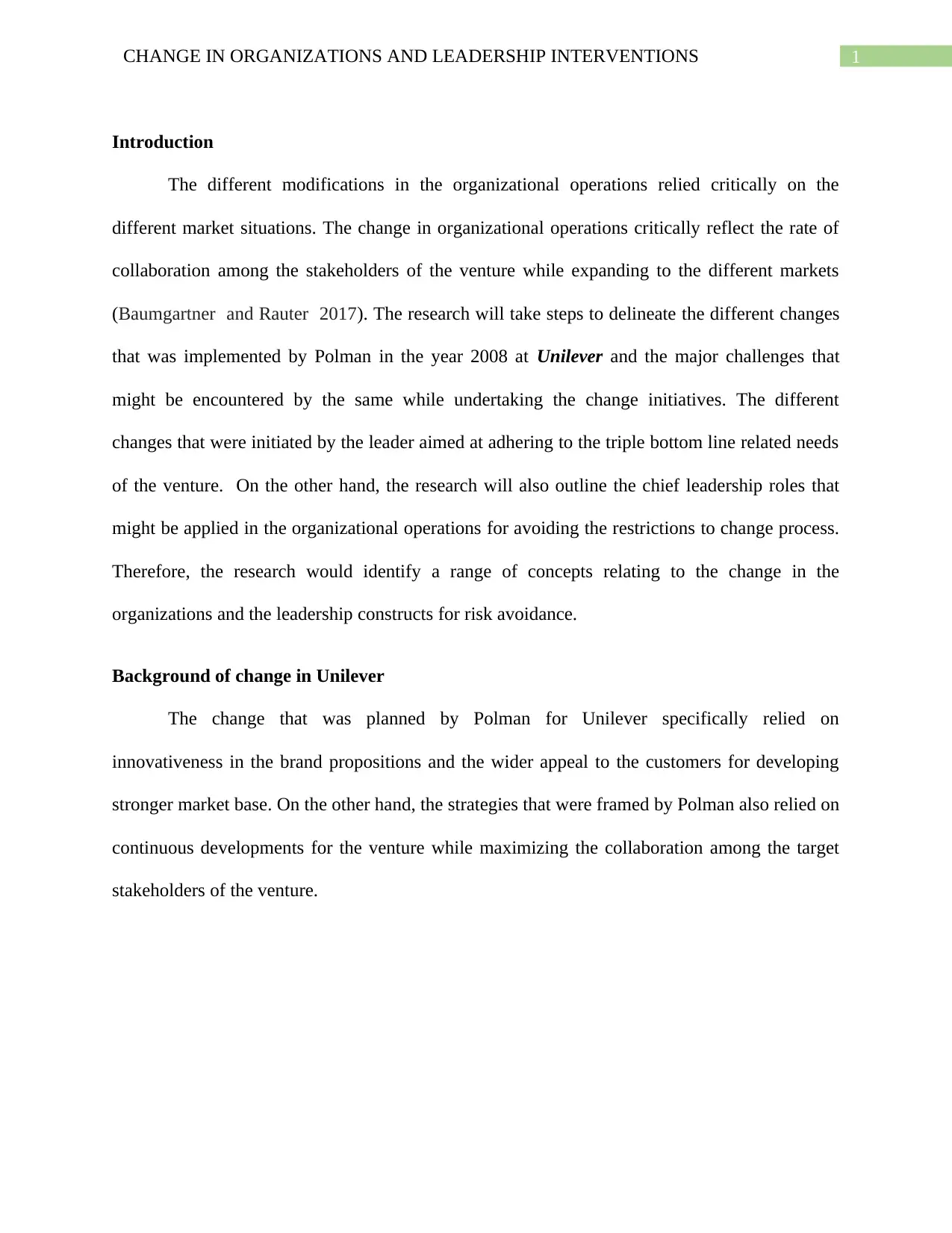
1CHANGE IN ORGANIZATIONS AND LEADERSHIP INTERVENTIONS
Introduction
The different modifications in the organizational operations relied critically on the
different market situations. The change in organizational operations critically reflect the rate of
collaboration among the stakeholders of the venture while expanding to the different markets
(Baumgartner and Rauter 2017). The research will take steps to delineate the different changes
that was implemented by Polman in the year 2008 at Unilever and the major challenges that
might be encountered by the same while undertaking the change initiatives. The different
changes that were initiated by the leader aimed at adhering to the triple bottom line related needs
of the venture. On the other hand, the research will also outline the chief leadership roles that
might be applied in the organizational operations for avoiding the restrictions to change process.
Therefore, the research would identify a range of concepts relating to the change in the
organizations and the leadership constructs for risk avoidance.
Background of change in Unilever
The change that was planned by Polman for Unilever specifically relied on
innovativeness in the brand propositions and the wider appeal to the customers for developing
stronger market base. On the other hand, the strategies that were framed by Polman also relied on
continuous developments for the venture while maximizing the collaboration among the target
stakeholders of the venture.
Introduction
The different modifications in the organizational operations relied critically on the
different market situations. The change in organizational operations critically reflect the rate of
collaboration among the stakeholders of the venture while expanding to the different markets
(Baumgartner and Rauter 2017). The research will take steps to delineate the different changes
that was implemented by Polman in the year 2008 at Unilever and the major challenges that
might be encountered by the same while undertaking the change initiatives. The different
changes that were initiated by the leader aimed at adhering to the triple bottom line related needs
of the venture. On the other hand, the research will also outline the chief leadership roles that
might be applied in the organizational operations for avoiding the restrictions to change process.
Therefore, the research would identify a range of concepts relating to the change in the
organizations and the leadership constructs for risk avoidance.
Background of change in Unilever
The change that was planned by Polman for Unilever specifically relied on
innovativeness in the brand propositions and the wider appeal to the customers for developing
stronger market base. On the other hand, the strategies that were framed by Polman also relied on
continuous developments for the venture while maximizing the collaboration among the target
stakeholders of the venture.
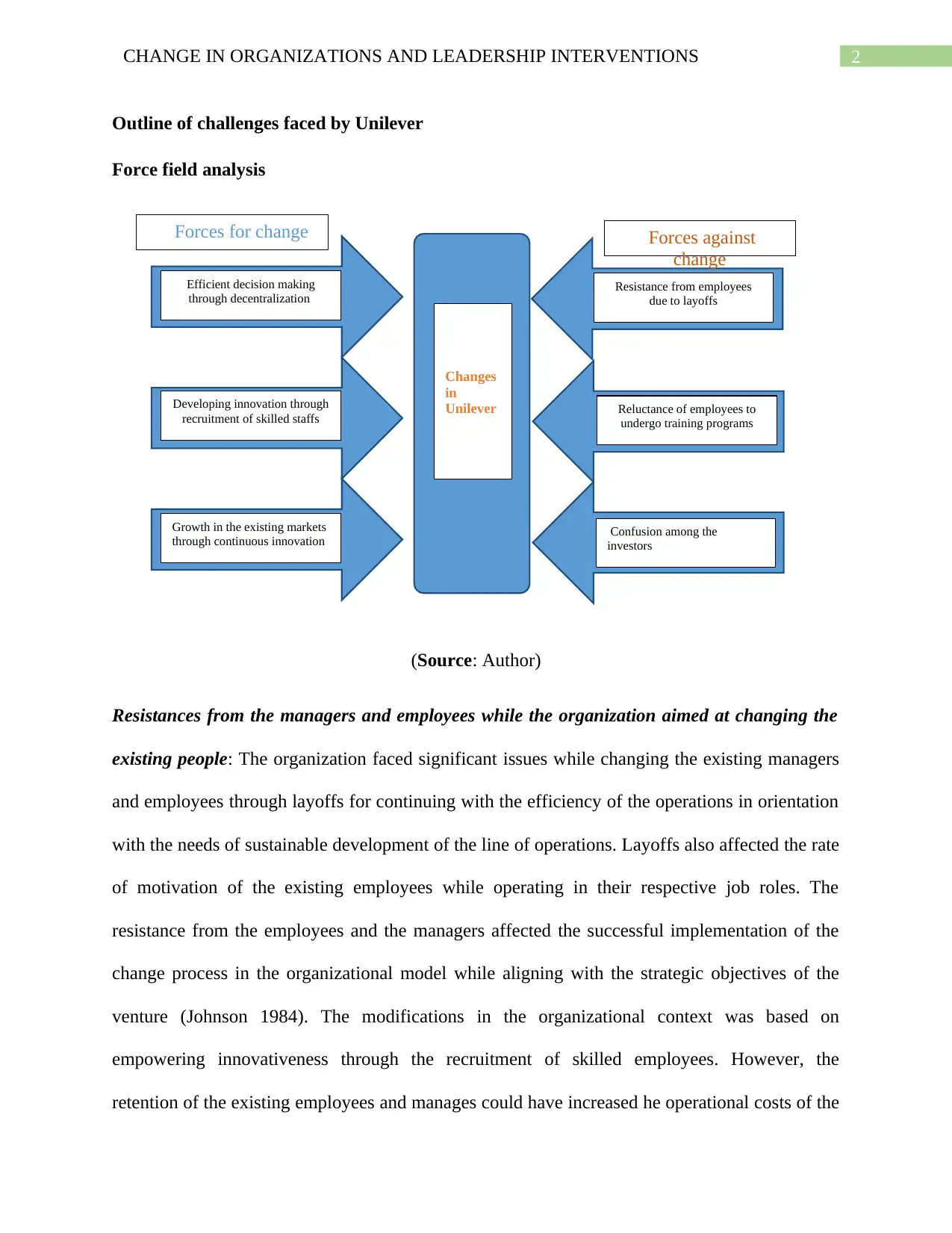
2CHANGE IN ORGANIZATIONS AND LEADERSHIP INTERVENTIONS
Changes
in
Unilever
Efficient decision making
through decentralization
Developing innovation through
recruitment of skilled staffs
Growth in the existing markets
through continuous innovation
Resistance from employees
due to layoffs
Reluctance of employees to
undergo training programs
Confusion among the
investors
Forces for change Forces against
change
Outline of challenges faced by Unilever
Force field analysis
(Source: Author)
Resistances from the managers and employees while the organization aimed at changing the
existing people: The organization faced significant issues while changing the existing managers
and employees through layoffs for continuing with the efficiency of the operations in orientation
with the needs of sustainable development of the line of operations. Layoffs also affected the rate
of motivation of the existing employees while operating in their respective job roles. The
resistance from the employees and the managers affected the successful implementation of the
change process in the organizational model while aligning with the strategic objectives of the
venture (Johnson 1984). The modifications in the organizational context was based on
empowering innovativeness through the recruitment of skilled employees. However, the
retention of the existing employees and manages could have increased he operational costs of the
Changes
in
Unilever
Efficient decision making
through decentralization
Developing innovation through
recruitment of skilled staffs
Growth in the existing markets
through continuous innovation
Resistance from employees
due to layoffs
Reluctance of employees to
undergo training programs
Confusion among the
investors
Forces for change Forces against
change
Outline of challenges faced by Unilever
Force field analysis
(Source: Author)
Resistances from the managers and employees while the organization aimed at changing the
existing people: The organization faced significant issues while changing the existing managers
and employees through layoffs for continuing with the efficiency of the operations in orientation
with the needs of sustainable development of the line of operations. Layoffs also affected the rate
of motivation of the existing employees while operating in their respective job roles. The
resistance from the employees and the managers affected the successful implementation of the
change process in the organizational model while aligning with the strategic objectives of the
venture (Johnson 1984). The modifications in the organizational context was based on
empowering innovativeness through the recruitment of skilled employees. However, the
retention of the existing employees and manages could have increased he operational costs of the
⊘ This is a preview!⊘
Do you want full access?
Subscribe today to unlock all pages.

Trusted by 1+ million students worldwide
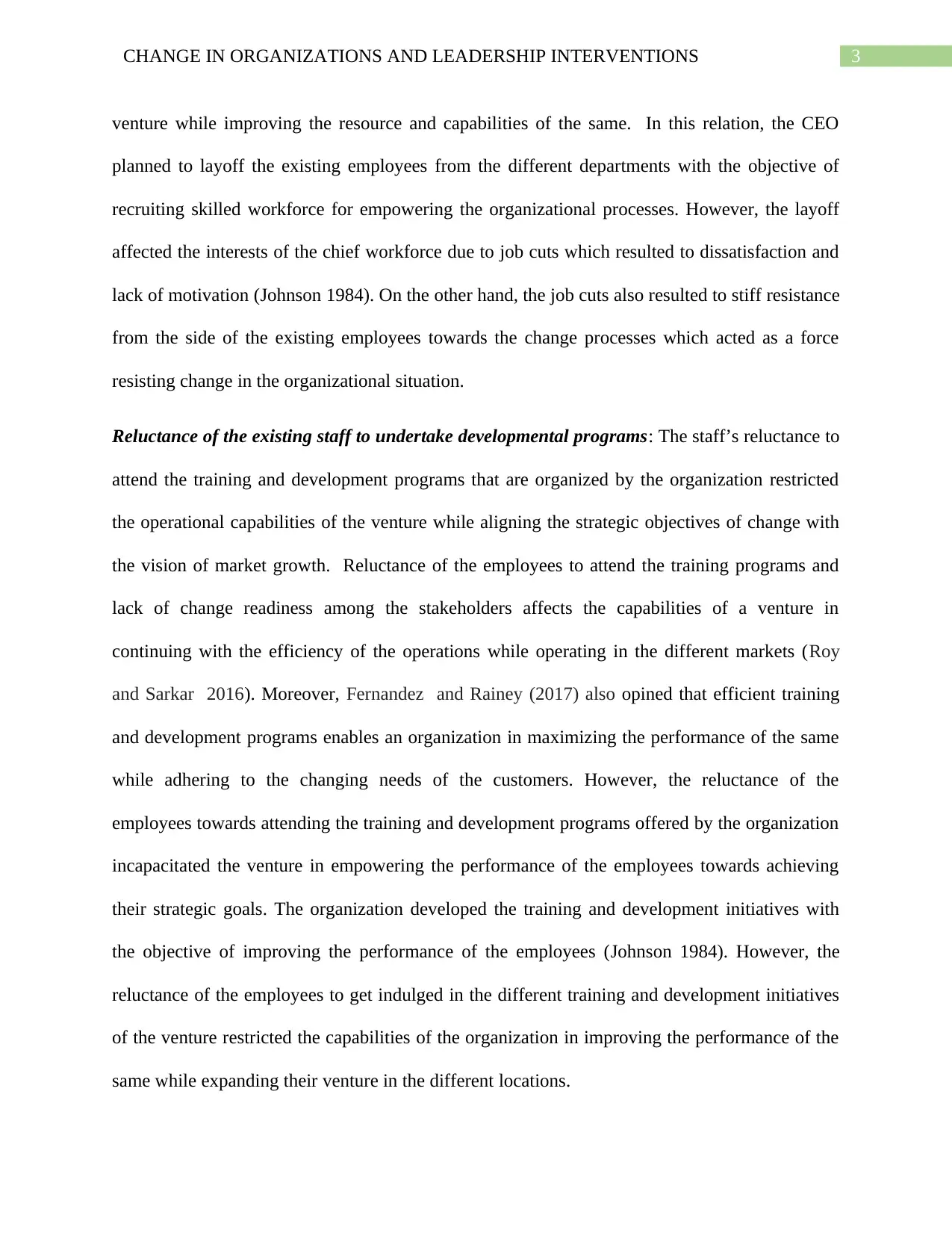
3CHANGE IN ORGANIZATIONS AND LEADERSHIP INTERVENTIONS
venture while improving the resource and capabilities of the same. In this relation, the CEO
planned to layoff the existing employees from the different departments with the objective of
recruiting skilled workforce for empowering the organizational processes. However, the layoff
affected the interests of the chief workforce due to job cuts which resulted to dissatisfaction and
lack of motivation (Johnson 1984). On the other hand, the job cuts also resulted to stiff resistance
from the side of the existing employees towards the change processes which acted as a force
resisting change in the organizational situation.
Reluctance of the existing staff to undertake developmental programs: The staff’s reluctance to
attend the training and development programs that are organized by the organization restricted
the operational capabilities of the venture while aligning the strategic objectives of change with
the vision of market growth. Reluctance of the employees to attend the training programs and
lack of change readiness among the stakeholders affects the capabilities of a venture in
continuing with the efficiency of the operations while operating in the different markets (Roy
and Sarkar 2016). Moreover, Fernandez and Rainey (2017) also opined that efficient training
and development programs enables an organization in maximizing the performance of the same
while adhering to the changing needs of the customers. However, the reluctance of the
employees towards attending the training and development programs offered by the organization
incapacitated the venture in empowering the performance of the employees towards achieving
their strategic goals. The organization developed the training and development initiatives with
the objective of improving the performance of the employees (Johnson 1984). However, the
reluctance of the employees to get indulged in the different training and development initiatives
of the venture restricted the capabilities of the organization in improving the performance of the
same while expanding their venture in the different locations.
venture while improving the resource and capabilities of the same. In this relation, the CEO
planned to layoff the existing employees from the different departments with the objective of
recruiting skilled workforce for empowering the organizational processes. However, the layoff
affected the interests of the chief workforce due to job cuts which resulted to dissatisfaction and
lack of motivation (Johnson 1984). On the other hand, the job cuts also resulted to stiff resistance
from the side of the existing employees towards the change processes which acted as a force
resisting change in the organizational situation.
Reluctance of the existing staff to undertake developmental programs: The staff’s reluctance to
attend the training and development programs that are organized by the organization restricted
the operational capabilities of the venture while aligning the strategic objectives of change with
the vision of market growth. Reluctance of the employees to attend the training programs and
lack of change readiness among the stakeholders affects the capabilities of a venture in
continuing with the efficiency of the operations while operating in the different markets (Roy
and Sarkar 2016). Moreover, Fernandez and Rainey (2017) also opined that efficient training
and development programs enables an organization in maximizing the performance of the same
while adhering to the changing needs of the customers. However, the reluctance of the
employees towards attending the training and development programs offered by the organization
incapacitated the venture in empowering the performance of the employees towards achieving
their strategic goals. The organization developed the training and development initiatives with
the objective of improving the performance of the employees (Johnson 1984). However, the
reluctance of the employees to get indulged in the different training and development initiatives
of the venture restricted the capabilities of the organization in improving the performance of the
same while expanding their venture in the different locations.
Paraphrase This Document
Need a fresh take? Get an instant paraphrase of this document with our AI Paraphraser
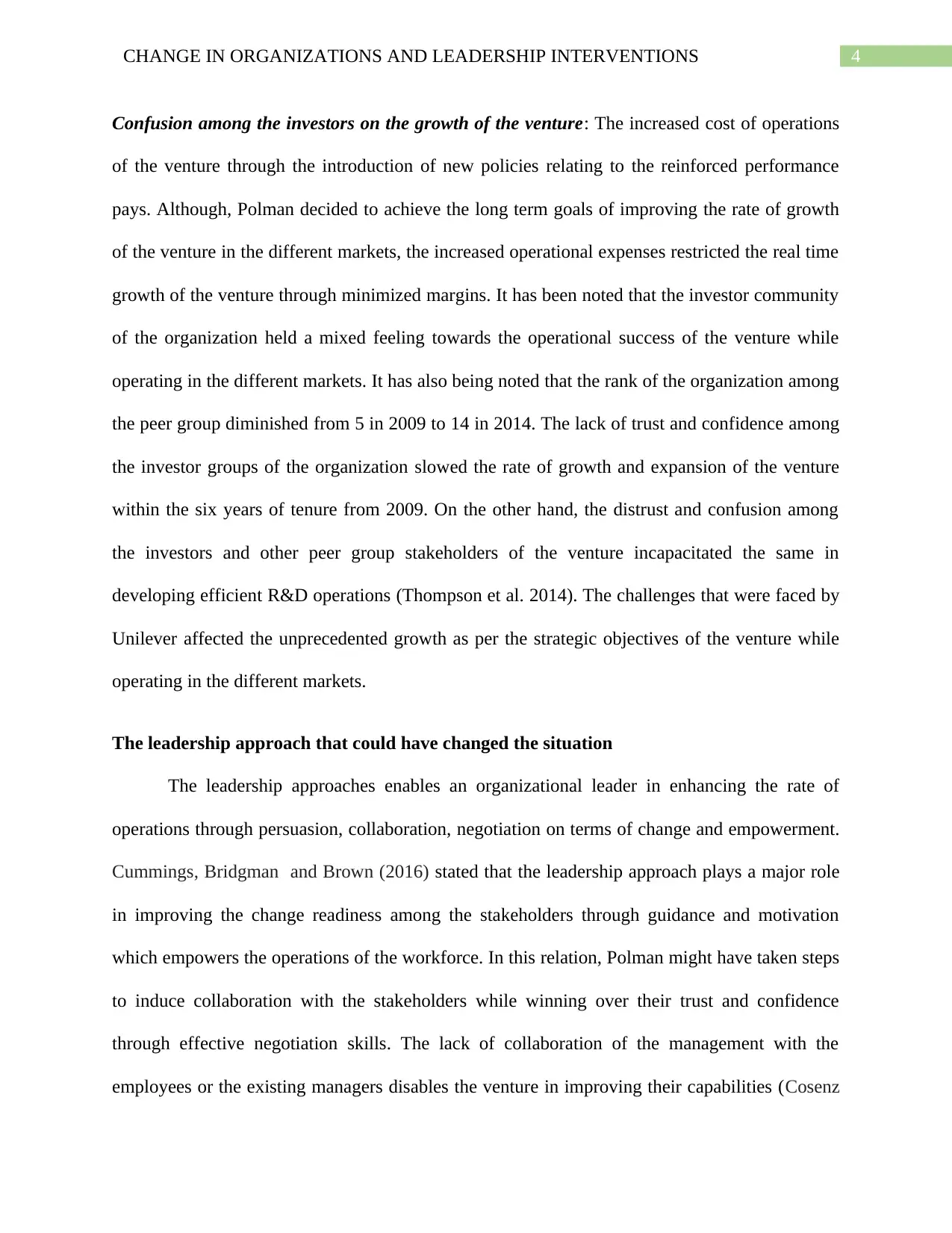
4CHANGE IN ORGANIZATIONS AND LEADERSHIP INTERVENTIONS
Confusion among the investors on the growth of the venture: The increased cost of operations
of the venture through the introduction of new policies relating to the reinforced performance
pays. Although, Polman decided to achieve the long term goals of improving the rate of growth
of the venture in the different markets, the increased operational expenses restricted the real time
growth of the venture through minimized margins. It has been noted that the investor community
of the organization held a mixed feeling towards the operational success of the venture while
operating in the different markets. It has also being noted that the rank of the organization among
the peer group diminished from 5 in 2009 to 14 in 2014. The lack of trust and confidence among
the investor groups of the organization slowed the rate of growth and expansion of the venture
within the six years of tenure from 2009. On the other hand, the distrust and confusion among
the investors and other peer group stakeholders of the venture incapacitated the same in
developing efficient R&D operations (Thompson et al. 2014). The challenges that were faced by
Unilever affected the unprecedented growth as per the strategic objectives of the venture while
operating in the different markets.
The leadership approach that could have changed the situation
The leadership approaches enables an organizational leader in enhancing the rate of
operations through persuasion, collaboration, negotiation on terms of change and empowerment.
Cummings, Bridgman and Brown (2016) stated that the leadership approach plays a major role
in improving the change readiness among the stakeholders through guidance and motivation
which empowers the operations of the workforce. In this relation, Polman might have taken steps
to induce collaboration with the stakeholders while winning over their trust and confidence
through effective negotiation skills. The lack of collaboration of the management with the
employees or the existing managers disables the venture in improving their capabilities (Cosenz
Confusion among the investors on the growth of the venture: The increased cost of operations
of the venture through the introduction of new policies relating to the reinforced performance
pays. Although, Polman decided to achieve the long term goals of improving the rate of growth
of the venture in the different markets, the increased operational expenses restricted the real time
growth of the venture through minimized margins. It has been noted that the investor community
of the organization held a mixed feeling towards the operational success of the venture while
operating in the different markets. It has also being noted that the rank of the organization among
the peer group diminished from 5 in 2009 to 14 in 2014. The lack of trust and confidence among
the investor groups of the organization slowed the rate of growth and expansion of the venture
within the six years of tenure from 2009. On the other hand, the distrust and confusion among
the investors and other peer group stakeholders of the venture incapacitated the same in
developing efficient R&D operations (Thompson et al. 2014). The challenges that were faced by
Unilever affected the unprecedented growth as per the strategic objectives of the venture while
operating in the different markets.
The leadership approach that could have changed the situation
The leadership approaches enables an organizational leader in enhancing the rate of
operations through persuasion, collaboration, negotiation on terms of change and empowerment.
Cummings, Bridgman and Brown (2016) stated that the leadership approach plays a major role
in improving the change readiness among the stakeholders through guidance and motivation
which empowers the operations of the workforce. In this relation, Polman might have taken steps
to induce collaboration with the stakeholders while winning over their trust and confidence
through effective negotiation skills. The lack of collaboration of the management with the
employees or the existing managers disables the venture in improving their capabilities (Cosenz
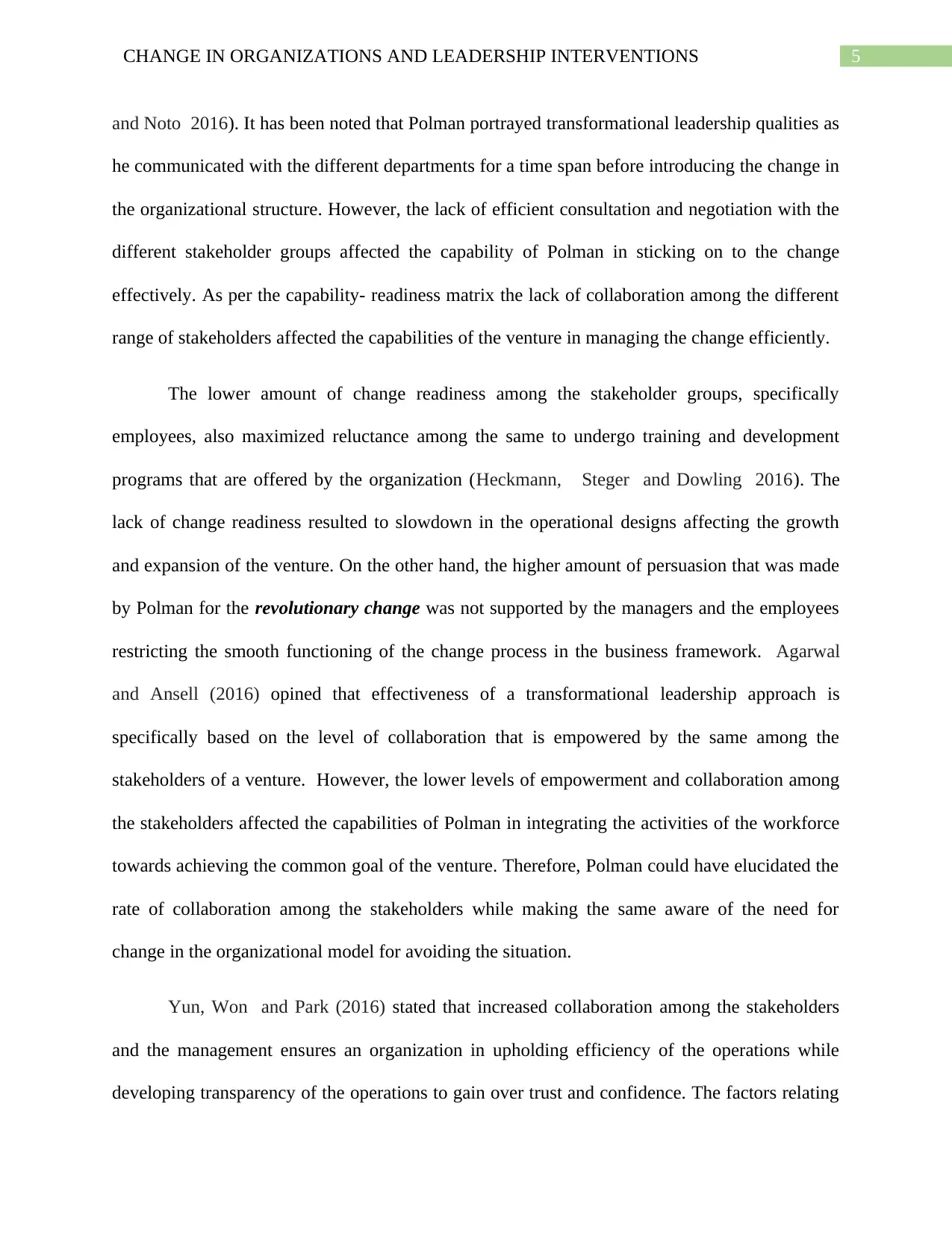
5CHANGE IN ORGANIZATIONS AND LEADERSHIP INTERVENTIONS
and Noto 2016). It has been noted that Polman portrayed transformational leadership qualities as
he communicated with the different departments for a time span before introducing the change in
the organizational structure. However, the lack of efficient consultation and negotiation with the
different stakeholder groups affected the capability of Polman in sticking on to the change
effectively. As per the capability- readiness matrix the lack of collaboration among the different
range of stakeholders affected the capabilities of the venture in managing the change efficiently.
The lower amount of change readiness among the stakeholder groups, specifically
employees, also maximized reluctance among the same to undergo training and development
programs that are offered by the organization (Heckmann, Steger and Dowling 2016). The
lack of change readiness resulted to slowdown in the operational designs affecting the growth
and expansion of the venture. On the other hand, the higher amount of persuasion that was made
by Polman for the revolutionary change was not supported by the managers and the employees
restricting the smooth functioning of the change process in the business framework. Agarwal
and Ansell (2016) opined that effectiveness of a transformational leadership approach is
specifically based on the level of collaboration that is empowered by the same among the
stakeholders of a venture. However, the lower levels of empowerment and collaboration among
the stakeholders affected the capabilities of Polman in integrating the activities of the workforce
towards achieving the common goal of the venture. Therefore, Polman could have elucidated the
rate of collaboration among the stakeholders while making the same aware of the need for
change in the organizational model for avoiding the situation.
Yun, Won and Park (2016) stated that increased collaboration among the stakeholders
and the management ensures an organization in upholding efficiency of the operations while
developing transparency of the operations to gain over trust and confidence. The factors relating
and Noto 2016). It has been noted that Polman portrayed transformational leadership qualities as
he communicated with the different departments for a time span before introducing the change in
the organizational structure. However, the lack of efficient consultation and negotiation with the
different stakeholder groups affected the capability of Polman in sticking on to the change
effectively. As per the capability- readiness matrix the lack of collaboration among the different
range of stakeholders affected the capabilities of the venture in managing the change efficiently.
The lower amount of change readiness among the stakeholder groups, specifically
employees, also maximized reluctance among the same to undergo training and development
programs that are offered by the organization (Heckmann, Steger and Dowling 2016). The
lack of change readiness resulted to slowdown in the operational designs affecting the growth
and expansion of the venture. On the other hand, the higher amount of persuasion that was made
by Polman for the revolutionary change was not supported by the managers and the employees
restricting the smooth functioning of the change process in the business framework. Agarwal
and Ansell (2016) opined that effectiveness of a transformational leadership approach is
specifically based on the level of collaboration that is empowered by the same among the
stakeholders of a venture. However, the lower levels of empowerment and collaboration among
the stakeholders affected the capabilities of Polman in integrating the activities of the workforce
towards achieving the common goal of the venture. Therefore, Polman could have elucidated the
rate of collaboration among the stakeholders while making the same aware of the need for
change in the organizational model for avoiding the situation.
Yun, Won and Park (2016) stated that increased collaboration among the stakeholders
and the management ensures an organization in upholding efficiency of the operations while
developing transparency of the operations to gain over trust and confidence. The factors relating
⊘ This is a preview!⊘
Do you want full access?
Subscribe today to unlock all pages.

Trusted by 1+ million students worldwide
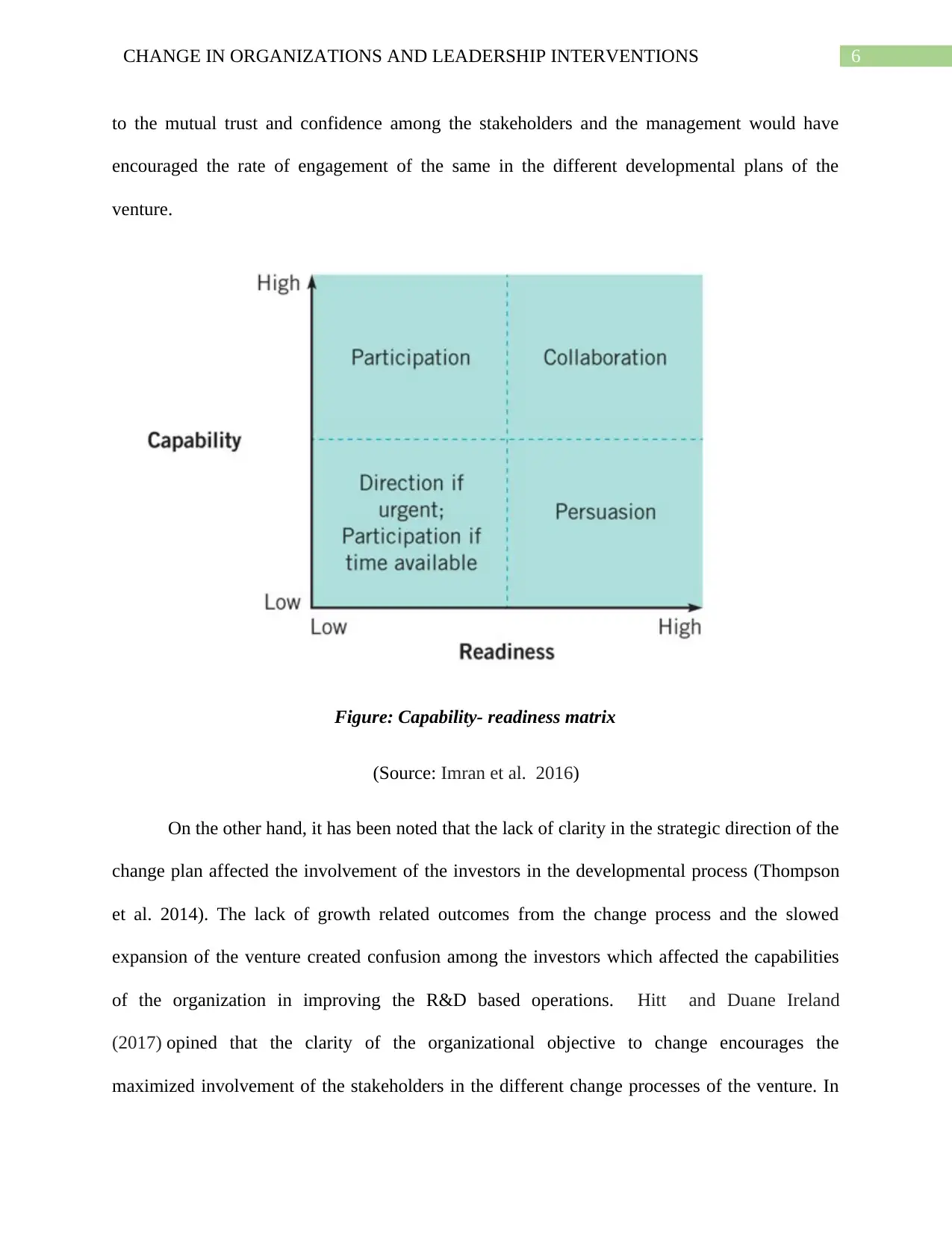
6CHANGE IN ORGANIZATIONS AND LEADERSHIP INTERVENTIONS
to the mutual trust and confidence among the stakeholders and the management would have
encouraged the rate of engagement of the same in the different developmental plans of the
venture.
Figure: Capability- readiness matrix
(Source: Imran et al. 2016)
On the other hand, it has been noted that the lack of clarity in the strategic direction of the
change plan affected the involvement of the investors in the developmental process (Thompson
et al. 2014). The lack of growth related outcomes from the change process and the slowed
expansion of the venture created confusion among the investors which affected the capabilities
of the organization in improving the R&D based operations. Hitt and Duane Ireland
(2017) opined that the clarity of the organizational objective to change encourages the
maximized involvement of the stakeholders in the different change processes of the venture. In
to the mutual trust and confidence among the stakeholders and the management would have
encouraged the rate of engagement of the same in the different developmental plans of the
venture.
Figure: Capability- readiness matrix
(Source: Imran et al. 2016)
On the other hand, it has been noted that the lack of clarity in the strategic direction of the
change plan affected the involvement of the investors in the developmental process (Thompson
et al. 2014). The lack of growth related outcomes from the change process and the slowed
expansion of the venture created confusion among the investors which affected the capabilities
of the organization in improving the R&D based operations. Hitt and Duane Ireland
(2017) opined that the clarity of the organizational objective to change encourages the
maximized involvement of the stakeholders in the different change processes of the venture. In
Paraphrase This Document
Need a fresh take? Get an instant paraphrase of this document with our AI Paraphraser
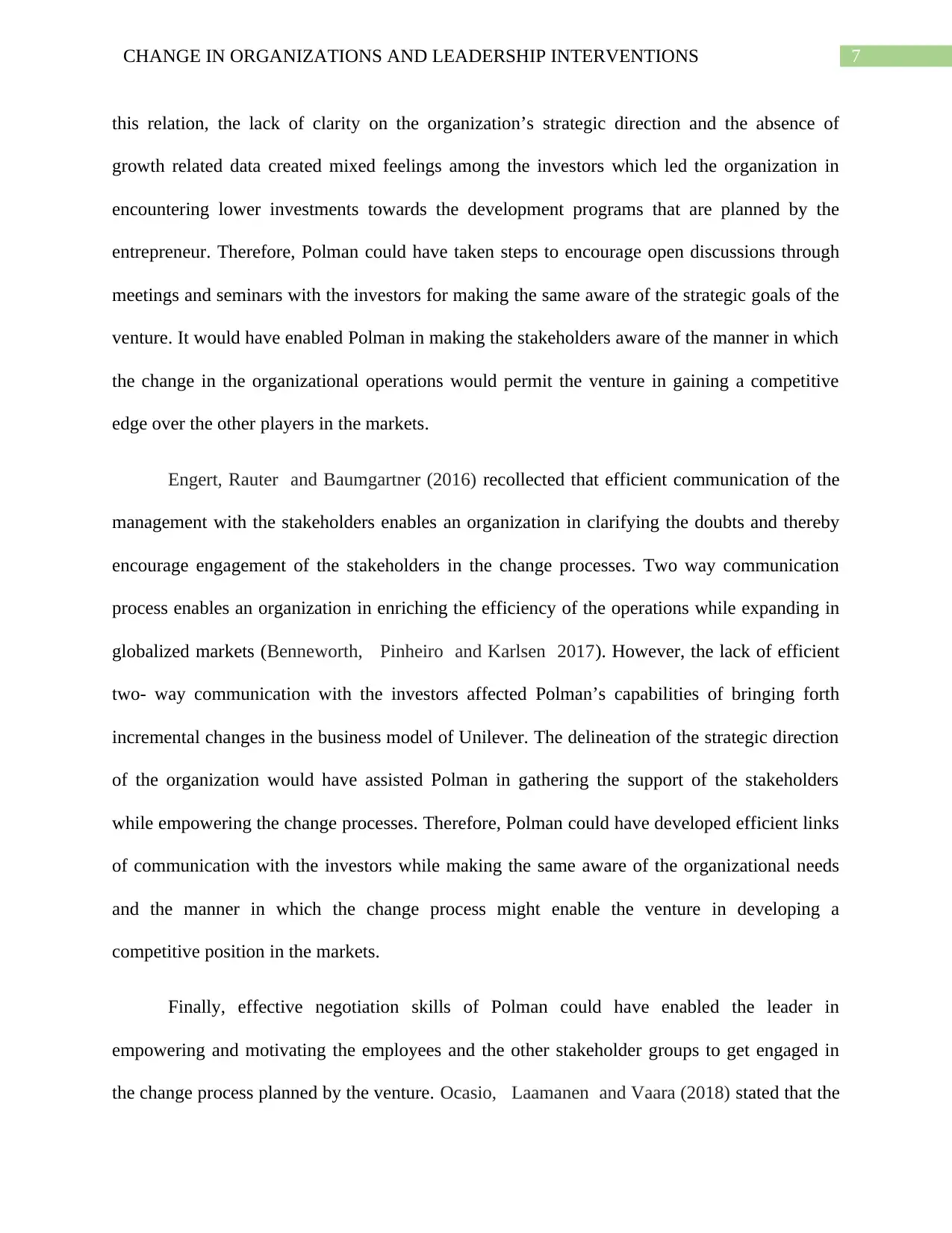
7CHANGE IN ORGANIZATIONS AND LEADERSHIP INTERVENTIONS
this relation, the lack of clarity on the organization’s strategic direction and the absence of
growth related data created mixed feelings among the investors which led the organization in
encountering lower investments towards the development programs that are planned by the
entrepreneur. Therefore, Polman could have taken steps to encourage open discussions through
meetings and seminars with the investors for making the same aware of the strategic goals of the
venture. It would have enabled Polman in making the stakeholders aware of the manner in which
the change in the organizational operations would permit the venture in gaining a competitive
edge over the other players in the markets.
Engert, Rauter and Baumgartner (2016) recollected that efficient communication of the
management with the stakeholders enables an organization in clarifying the doubts and thereby
encourage engagement of the stakeholders in the change processes. Two way communication
process enables an organization in enriching the efficiency of the operations while expanding in
globalized markets (Benneworth, Pinheiro and Karlsen 2017). However, the lack of efficient
two- way communication with the investors affected Polman’s capabilities of bringing forth
incremental changes in the business model of Unilever. The delineation of the strategic direction
of the organization would have assisted Polman in gathering the support of the stakeholders
while empowering the change processes. Therefore, Polman could have developed efficient links
of communication with the investors while making the same aware of the organizational needs
and the manner in which the change process might enable the venture in developing a
competitive position in the markets.
Finally, effective negotiation skills of Polman could have enabled the leader in
empowering and motivating the employees and the other stakeholder groups to get engaged in
the change process planned by the venture. Ocasio, Laamanen and Vaara (2018) stated that the
this relation, the lack of clarity on the organization’s strategic direction and the absence of
growth related data created mixed feelings among the investors which led the organization in
encountering lower investments towards the development programs that are planned by the
entrepreneur. Therefore, Polman could have taken steps to encourage open discussions through
meetings and seminars with the investors for making the same aware of the strategic goals of the
venture. It would have enabled Polman in making the stakeholders aware of the manner in which
the change in the organizational operations would permit the venture in gaining a competitive
edge over the other players in the markets.
Engert, Rauter and Baumgartner (2016) recollected that efficient communication of the
management with the stakeholders enables an organization in clarifying the doubts and thereby
encourage engagement of the stakeholders in the change processes. Two way communication
process enables an organization in enriching the efficiency of the operations while expanding in
globalized markets (Benneworth, Pinheiro and Karlsen 2017). However, the lack of efficient
two- way communication with the investors affected Polman’s capabilities of bringing forth
incremental changes in the business model of Unilever. The delineation of the strategic direction
of the organization would have assisted Polman in gathering the support of the stakeholders
while empowering the change processes. Therefore, Polman could have developed efficient links
of communication with the investors while making the same aware of the organizational needs
and the manner in which the change process might enable the venture in developing a
competitive position in the markets.
Finally, effective negotiation skills of Polman could have enabled the leader in
empowering and motivating the employees and the other stakeholder groups to get engaged in
the change process planned by the venture. Ocasio, Laamanen and Vaara (2018) stated that the
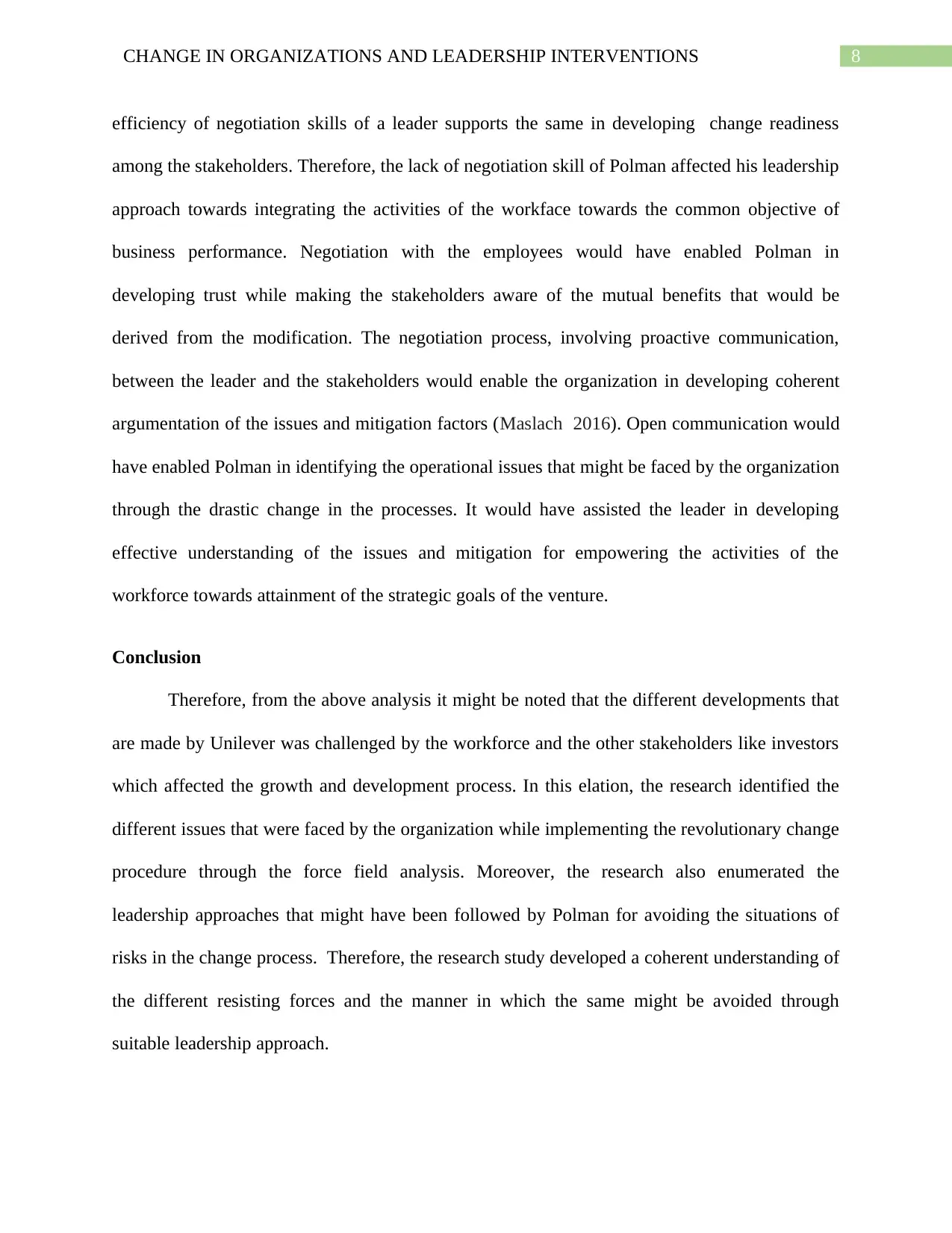
8CHANGE IN ORGANIZATIONS AND LEADERSHIP INTERVENTIONS
efficiency of negotiation skills of a leader supports the same in developing change readiness
among the stakeholders. Therefore, the lack of negotiation skill of Polman affected his leadership
approach towards integrating the activities of the workface towards the common objective of
business performance. Negotiation with the employees would have enabled Polman in
developing trust while making the stakeholders aware of the mutual benefits that would be
derived from the modification. The negotiation process, involving proactive communication,
between the leader and the stakeholders would enable the organization in developing coherent
argumentation of the issues and mitigation factors (Maslach 2016). Open communication would
have enabled Polman in identifying the operational issues that might be faced by the organization
through the drastic change in the processes. It would have assisted the leader in developing
effective understanding of the issues and mitigation for empowering the activities of the
workforce towards attainment of the strategic goals of the venture.
Conclusion
Therefore, from the above analysis it might be noted that the different developments that
are made by Unilever was challenged by the workforce and the other stakeholders like investors
which affected the growth and development process. In this elation, the research identified the
different issues that were faced by the organization while implementing the revolutionary change
procedure through the force field analysis. Moreover, the research also enumerated the
leadership approaches that might have been followed by Polman for avoiding the situations of
risks in the change process. Therefore, the research study developed a coherent understanding of
the different resisting forces and the manner in which the same might be avoided through
suitable leadership approach.
efficiency of negotiation skills of a leader supports the same in developing change readiness
among the stakeholders. Therefore, the lack of negotiation skill of Polman affected his leadership
approach towards integrating the activities of the workface towards the common objective of
business performance. Negotiation with the employees would have enabled Polman in
developing trust while making the stakeholders aware of the mutual benefits that would be
derived from the modification. The negotiation process, involving proactive communication,
between the leader and the stakeholders would enable the organization in developing coherent
argumentation of the issues and mitigation factors (Maslach 2016). Open communication would
have enabled Polman in identifying the operational issues that might be faced by the organization
through the drastic change in the processes. It would have assisted the leader in developing
effective understanding of the issues and mitigation for empowering the activities of the
workforce towards attainment of the strategic goals of the venture.
Conclusion
Therefore, from the above analysis it might be noted that the different developments that
are made by Unilever was challenged by the workforce and the other stakeholders like investors
which affected the growth and development process. In this elation, the research identified the
different issues that were faced by the organization while implementing the revolutionary change
procedure through the force field analysis. Moreover, the research also enumerated the
leadership approaches that might have been followed by Polman for avoiding the situations of
risks in the change process. Therefore, the research study developed a coherent understanding of
the different resisting forces and the manner in which the same might be avoided through
suitable leadership approach.
⊘ This is a preview!⊘
Do you want full access?
Subscribe today to unlock all pages.

Trusted by 1+ million students worldwide
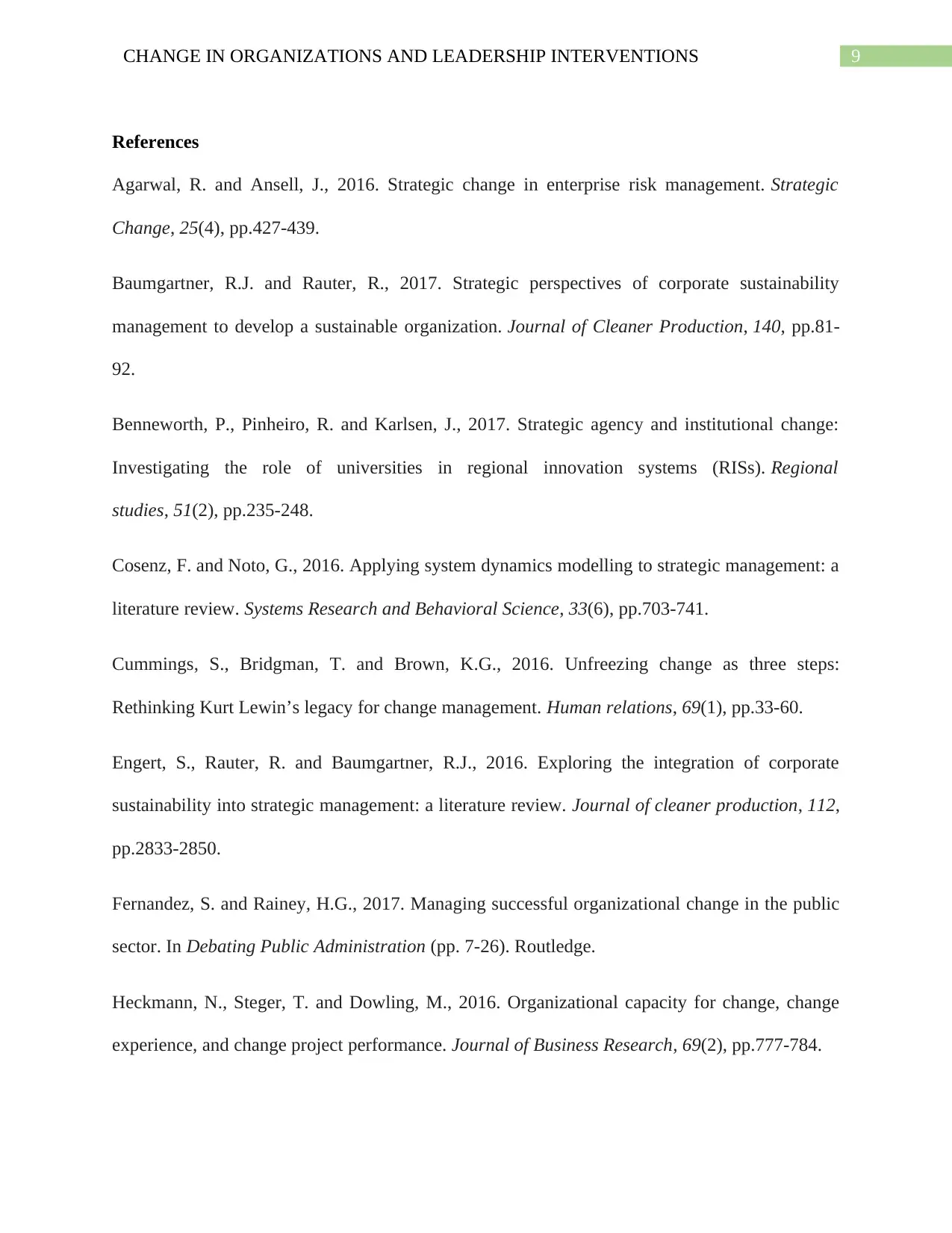
9CHANGE IN ORGANIZATIONS AND LEADERSHIP INTERVENTIONS
References
Agarwal, R. and Ansell, J., 2016. Strategic change in enterprise risk management. Strategic
Change, 25(4), pp.427-439.
Baumgartner, R.J. and Rauter, R., 2017. Strategic perspectives of corporate sustainability
management to develop a sustainable organization. Journal of Cleaner Production, 140, pp.81-
92.
Benneworth, P., Pinheiro, R. and Karlsen, J., 2017. Strategic agency and institutional change:
Investigating the role of universities in regional innovation systems (RISs). Regional
studies, 51(2), pp.235-248.
Cosenz, F. and Noto, G., 2016. Applying system dynamics modelling to strategic management: a
literature review. Systems Research and Behavioral Science, 33(6), pp.703-741.
Cummings, S., Bridgman, T. and Brown, K.G., 2016. Unfreezing change as three steps:
Rethinking Kurt Lewin’s legacy for change management. Human relations, 69(1), pp.33-60.
Engert, S., Rauter, R. and Baumgartner, R.J., 2016. Exploring the integration of corporate
sustainability into strategic management: a literature review. Journal of cleaner production, 112,
pp.2833-2850.
Fernandez, S. and Rainey, H.G., 2017. Managing successful organizational change in the public
sector. In Debating Public Administration (pp. 7-26). Routledge.
Heckmann, N., Steger, T. and Dowling, M., 2016. Organizational capacity for change, change
experience, and change project performance. Journal of Business Research, 69(2), pp.777-784.
References
Agarwal, R. and Ansell, J., 2016. Strategic change in enterprise risk management. Strategic
Change, 25(4), pp.427-439.
Baumgartner, R.J. and Rauter, R., 2017. Strategic perspectives of corporate sustainability
management to develop a sustainable organization. Journal of Cleaner Production, 140, pp.81-
92.
Benneworth, P., Pinheiro, R. and Karlsen, J., 2017. Strategic agency and institutional change:
Investigating the role of universities in regional innovation systems (RISs). Regional
studies, 51(2), pp.235-248.
Cosenz, F. and Noto, G., 2016. Applying system dynamics modelling to strategic management: a
literature review. Systems Research and Behavioral Science, 33(6), pp.703-741.
Cummings, S., Bridgman, T. and Brown, K.G., 2016. Unfreezing change as three steps:
Rethinking Kurt Lewin’s legacy for change management. Human relations, 69(1), pp.33-60.
Engert, S., Rauter, R. and Baumgartner, R.J., 2016. Exploring the integration of corporate
sustainability into strategic management: a literature review. Journal of cleaner production, 112,
pp.2833-2850.
Fernandez, S. and Rainey, H.G., 2017. Managing successful organizational change in the public
sector. In Debating Public Administration (pp. 7-26). Routledge.
Heckmann, N., Steger, T. and Dowling, M., 2016. Organizational capacity for change, change
experience, and change project performance. Journal of Business Research, 69(2), pp.777-784.
Paraphrase This Document
Need a fresh take? Get an instant paraphrase of this document with our AI Paraphraser
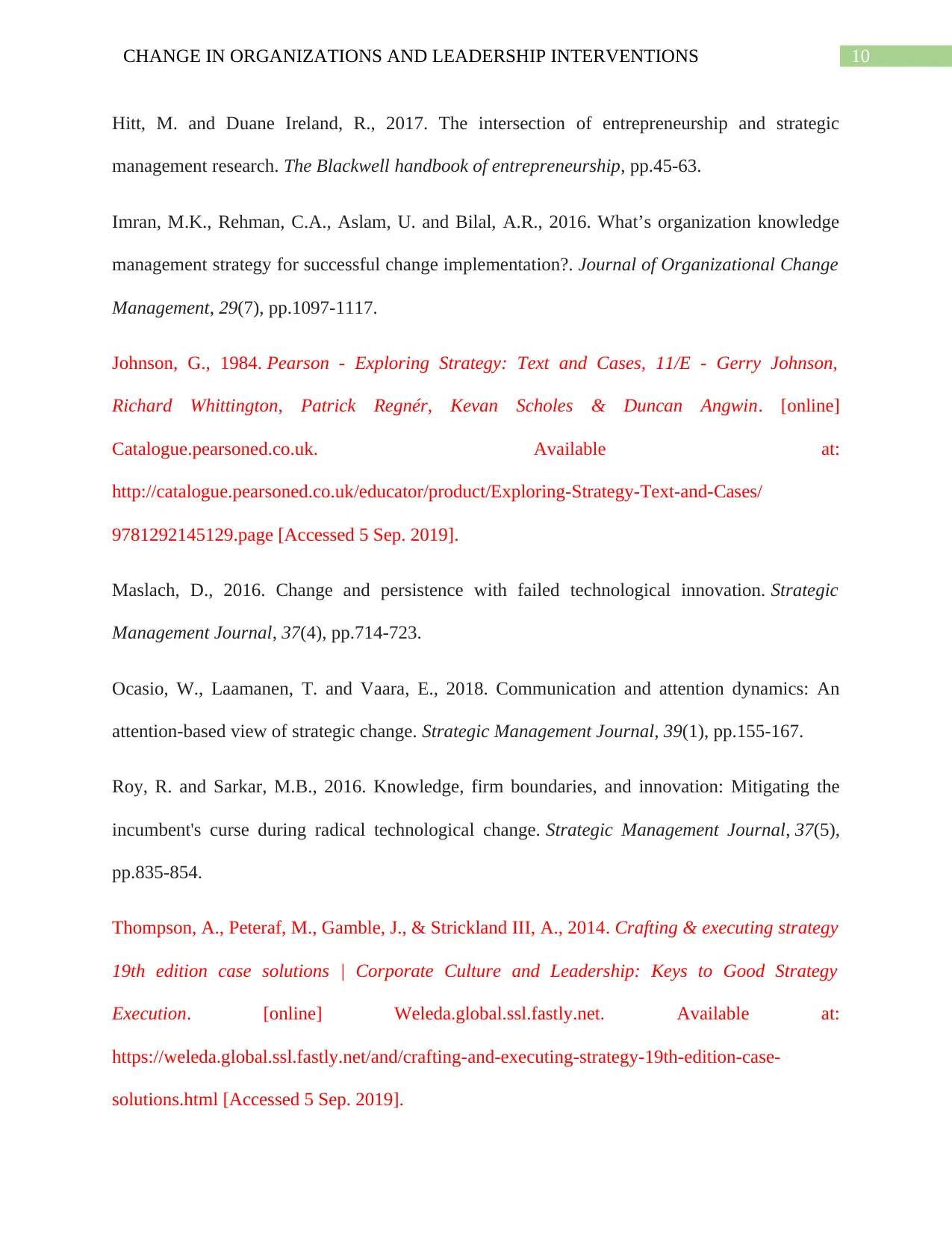
10CHANGE IN ORGANIZATIONS AND LEADERSHIP INTERVENTIONS
Hitt, M. and Duane Ireland, R., 2017. The intersection of entrepreneurship and strategic
management research. The Blackwell handbook of entrepreneurship, pp.45-63.
Imran, M.K., Rehman, C.A., Aslam, U. and Bilal, A.R., 2016. What’s organization knowledge
management strategy for successful change implementation?. Journal of Organizational Change
Management, 29(7), pp.1097-1117.
Johnson, G., 1984. Pearson - Exploring Strategy: Text and Cases, 11/E - Gerry Johnson,
Richard Whittington, Patrick Regnér, Kevan Scholes & Duncan Angwin. [online]
Catalogue.pearsoned.co.uk. Available at:
http://catalogue.pearsoned.co.uk/educator/product/Exploring-Strategy-Text-and-Cases/
9781292145129.page [Accessed 5 Sep. 2019].
Maslach, D., 2016. Change and persistence with failed technological innovation. Strategic
Management Journal, 37(4), pp.714-723.
Ocasio, W., Laamanen, T. and Vaara, E., 2018. Communication and attention dynamics: An
attention‐based view of strategic change. Strategic Management Journal, 39(1), pp.155-167.
Roy, R. and Sarkar, M.B., 2016. Knowledge, firm boundaries, and innovation: Mitigating the
incumbent's curse during radical technological change. Strategic Management Journal, 37(5),
pp.835-854.
Thompson, A., Peteraf, M., Gamble, J., & Strickland III, A., 2014. Crafting & executing strategy
19th edition case solutions | Corporate Culture and Leadership: Keys to Good Strategy
Execution. [online] Weleda.global.ssl.fastly.net. Available at:
https://weleda.global.ssl.fastly.net/and/crafting-and-executing-strategy-19th-edition-case-
solutions.html [Accessed 5 Sep. 2019].
Hitt, M. and Duane Ireland, R., 2017. The intersection of entrepreneurship and strategic
management research. The Blackwell handbook of entrepreneurship, pp.45-63.
Imran, M.K., Rehman, C.A., Aslam, U. and Bilal, A.R., 2016. What’s organization knowledge
management strategy for successful change implementation?. Journal of Organizational Change
Management, 29(7), pp.1097-1117.
Johnson, G., 1984. Pearson - Exploring Strategy: Text and Cases, 11/E - Gerry Johnson,
Richard Whittington, Patrick Regnér, Kevan Scholes & Duncan Angwin. [online]
Catalogue.pearsoned.co.uk. Available at:
http://catalogue.pearsoned.co.uk/educator/product/Exploring-Strategy-Text-and-Cases/
9781292145129.page [Accessed 5 Sep. 2019].
Maslach, D., 2016. Change and persistence with failed technological innovation. Strategic
Management Journal, 37(4), pp.714-723.
Ocasio, W., Laamanen, T. and Vaara, E., 2018. Communication and attention dynamics: An
attention‐based view of strategic change. Strategic Management Journal, 39(1), pp.155-167.
Roy, R. and Sarkar, M.B., 2016. Knowledge, firm boundaries, and innovation: Mitigating the
incumbent's curse during radical technological change. Strategic Management Journal, 37(5),
pp.835-854.
Thompson, A., Peteraf, M., Gamble, J., & Strickland III, A., 2014. Crafting & executing strategy
19th edition case solutions | Corporate Culture and Leadership: Keys to Good Strategy
Execution. [online] Weleda.global.ssl.fastly.net. Available at:
https://weleda.global.ssl.fastly.net/and/crafting-and-executing-strategy-19th-edition-case-
solutions.html [Accessed 5 Sep. 2019].
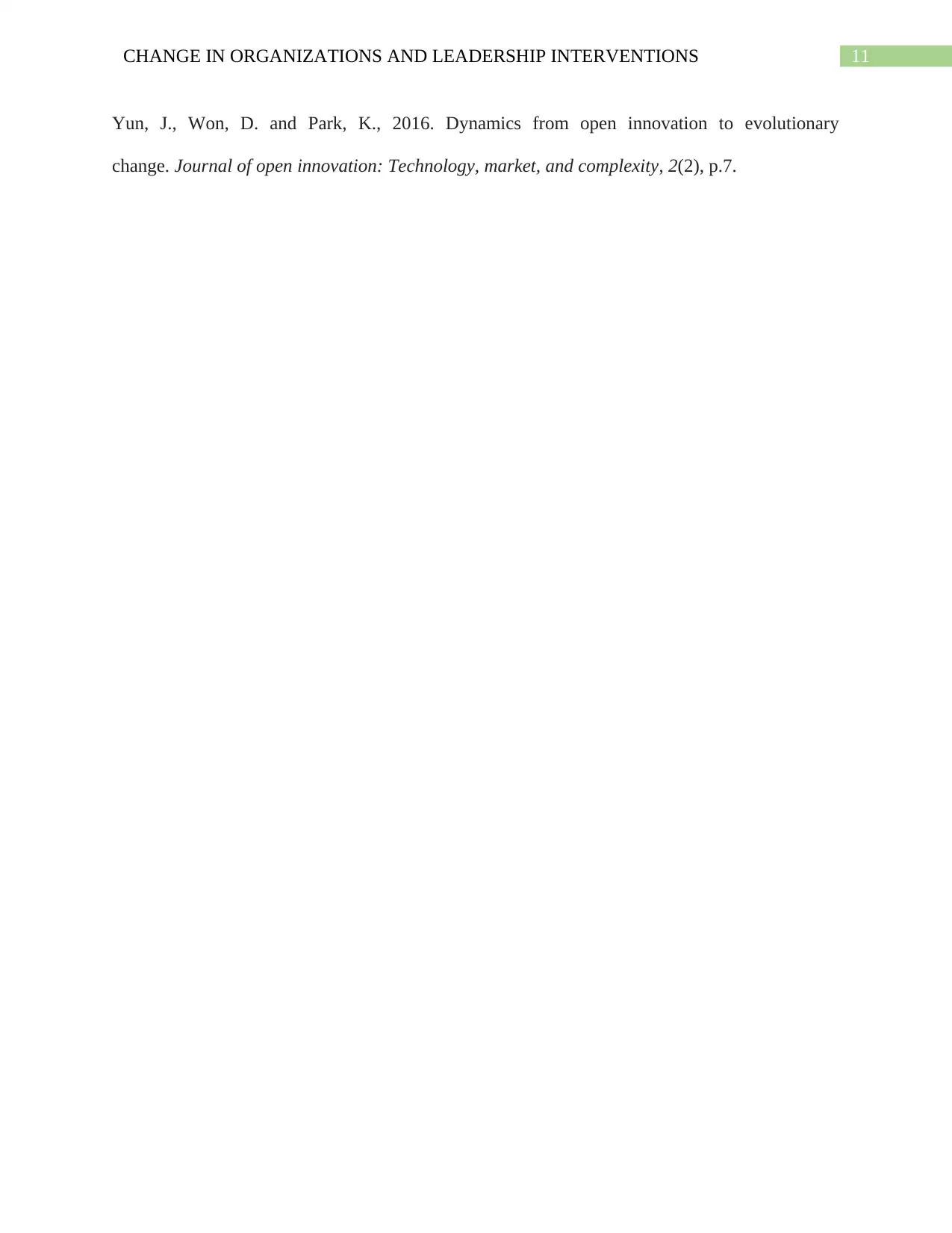
11CHANGE IN ORGANIZATIONS AND LEADERSHIP INTERVENTIONS
Yun, J., Won, D. and Park, K., 2016. Dynamics from open innovation to evolutionary
change. Journal of open innovation: Technology, market, and complexity, 2(2), p.7.
Yun, J., Won, D. and Park, K., 2016. Dynamics from open innovation to evolutionary
change. Journal of open innovation: Technology, market, and complexity, 2(2), p.7.
⊘ This is a preview!⊘
Do you want full access?
Subscribe today to unlock all pages.

Trusted by 1+ million students worldwide
1 out of 12
Related Documents
Your All-in-One AI-Powered Toolkit for Academic Success.
+13062052269
info@desklib.com
Available 24*7 on WhatsApp / Email
![[object Object]](/_next/static/media/star-bottom.7253800d.svg)
Unlock your academic potential
Copyright © 2020–2025 A2Z Services. All Rights Reserved. Developed and managed by ZUCOL.





